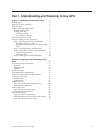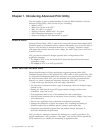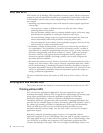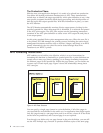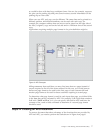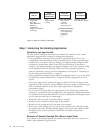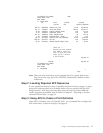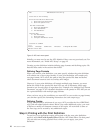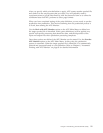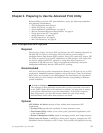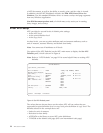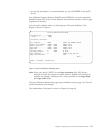
Step 1: Analyzing the Existing Application
Questions you need to Ask
The first step in creating a document is to examine the contents of the current
application program that is output by asking these questions:
v Is the application currently being printed on preprinted forms? If so, how
complicated is the information on the preprinted forms? If the preprinted form
contains only a few boxes and text strings, you might consider using the APU
functions to include those items in the APU print definition. If the form is
complex, you should probably use another program, such as the Overlay Utility
in the Advanced Function Printing Utilities for iSeries program product, to
create an electronic overlay. For more information, see Chapter 2, “Preparing to
Use the Advanced Print Utility” on page 13.
v Is the application currently being printed on multipart forms? If so, do the forms
all contain the same information, or is some of the data suppressed on some
copies?
v Is the same page format used for all pages in the file? Could you improve the
appearance of the output by using a different format for pages of different types,
such as a different layout for the first output page than for subsequent
continuation pages?
v If you want to use more than one page format in the AFP output, examine the
contents of a spooled file that is produced by the application. What information
is contained in the print data that APU can use to determine which page format
is to be used for each type of output page?
v What fonts will you need to produce effective output?
v Would you like to add any image data to the output?
v Would you like to add any bar code data to the output?
v What type of AFP printer will you use to print the job? Some AFP printers do
not support all of the AFP data stream objects, such as bar codes. Refer to IBM
Printing Systems: Printer Information, S544-5750, for details about printer
capabilities.
Example of Sample Spooled File (Source Input Data)
An example of the sample spooled file (source input data) that you would use to
build a print definition is given below:
Analyze the
SCS job
Create
AFP Resources
with AFP tools
Create the
Print Definition
Run the
Print Definition
Document structure
- Page format
- Page copy
- Data identification
- Resources
identification
- Trigger for conditional
processing
Define APU Defaults
. . .
Create print definition
. . .
- Select unit of
measure
- Select font
- Select paper size
-
- Define page format
- (cond. processing)
- Create copy
- (Mapping)
- ( )
- Font
- Page Segment
- Overlay
Run APU manually
Work with APU monitor
Figure 4. Steps to Creating a Document
8 APU User’s Guide




